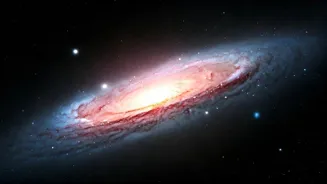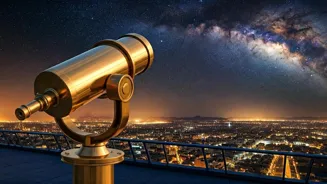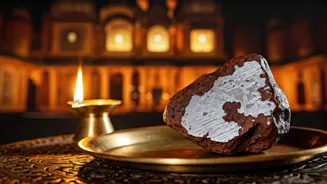Uncover the hidden hero of star birth: cosmic dust. Indian astronomers delve into its pivotal role, shaping the cosmos. Explore more!
When we look up at the night sky, twinkling stars fill us with wonder.
But have you ever wondered how these celestial giants come into existence? While gravity plays a crucial role, there's another, often overlooked, player in this cosmic drama: cosmic dust.
This isn't your everyday household dust; it’s a collection of tiny solid particles floating in the vast emptiness of space, and Indian researchers are increasingly focusing on understanding its pivotal role in star formation.
Understanding cosmic dust provides key pieces of information to various fields of astrophysics, including understanding the history of the universe itself. Several Indian astronomy initiatives are contributing to furthering research on this complex topic.
Cosmic dust: essential building blocks in space
Cosmic dust might seem insignificant when compared to the sheer size and energy of stars, but its contributions are vital. Think of it as the scaffolding used to build a magnificent skyscraper.
These micro-sized grains, much smaller than the width of a human hair, are composed of elements like carbon, silicon, oxygen, and iron.
Formed in the atmospheres of dying stars and ejected into space through powerful stellar winds and supernova explosions, they travel across interstellar space, eventually finding themselves within vast molecular clouds – the stellar nurseries where stars are born.
These clouds are primarily made of hydrogen and helium, but the presence of even small amounts of cosmic dust makes a significant difference. The study of cosmic dust focuses on analyzing their features and composition. This is done with powerful telescopes and intricate software analysis.
Cosmic dust cools molecular clouds, aids molecule formation, crucial for star life
The first key function of cosmic dust is to act as a coolant. Molecular clouds, initially very hot, need to cool down to collapse under their own gravity. Dust grains radiate heat away from the cloud, allowing it to become denser and denser.
This process is like a cosmic air conditioner, bringing down the temperature and paving the way for the formation of dense clumps within the cloud. Secondly, cosmic dust provides surfaces upon which molecules can form.
In the cold, sparse environment of space, it's difficult for hydrogen atoms to find each other and form hydrogen molecules (H2), the most abundant molecule in the universe.
However, when a hydrogen atom collides with a dust grain, it can stick to its surface and eventually meet another hydrogen atom, readily forming H2. The formation of H2 is crucial because it is a very efficient coolant, further accelerating the collapse of the cloud.
This shows us that the lifecycle of a star relies heavily on the existence of cosmic dust particles.
Cosmic dust crucial in molecule formation in space
Imagine these dust grains as tiny gathering spots, providing a platform for the construction processes going on in space. Without these surfaces, the formation of many molecules essential for life would be severely hindered.
So, when we look at a distant galaxy and see the presence of complex molecules, most likely, cosmic dust played a facilitating role. It is known as "the stardust from exploded stars". The more that scientists research this dust, the more mysteries are unraveled.
The composition and behavior of dust grains can also tell us about the environments they have passed through.
Cosmic dust forms stars, planets, and life
These dense clumps, formed with the help of cosmic dust, are the seeds of stars. As the clumps continue to collapse under gravity, they heat up and eventually become protostars – baby stars that are still gathering mass from their surroundings.
This further increases the density of the core of the collapsing proto-star. A swirling disk of gas and dust, known as a protoplanetary disk, forms around the protostar. The dust grains within this disk collide and stick together, gradually growing larger and larger.
Over time, these dust particles can evolve into planetesimals – small, rocky bodies that are the building blocks of planets. Thus, the dust that initially helped form the star also contributes to the formation of planets around it.
These planets can one day hold life, and this shows us how closely linked cosmic event are to the existence of life.
Indian astronomers study cosmic dust with telescopes, models, and data to unravel cosmic mysteries
Indian astronomers are actively involved in studying cosmic dust using ground-based telescopes like the Giant Metrewave Radio Telescope (GMRT) and space-based observatories.
The data collected from these observations help us understand the composition, size distribution, and spatial distribution of cosmic dust in different regions of our galaxy and beyond.
Furthermore, Indian researchers are developing sophisticated computer models to simulate the behavior of cosmic dust and its role in star and planet formation. These models allow us to test our theories and make predictions that can be verified with future observations.
By combining observational data with theoretical modeling, Indian astronomers are making significant strides in unraveling the mysteries of cosmic dust and its crucial role in the grand cosmic dance of star birth.
This has led to India contributing significantly to the international astronomy community. The continued research contributes to the body of research worldwide.
AI Generated Content. Glance/InMobi shall have no liability for the content










